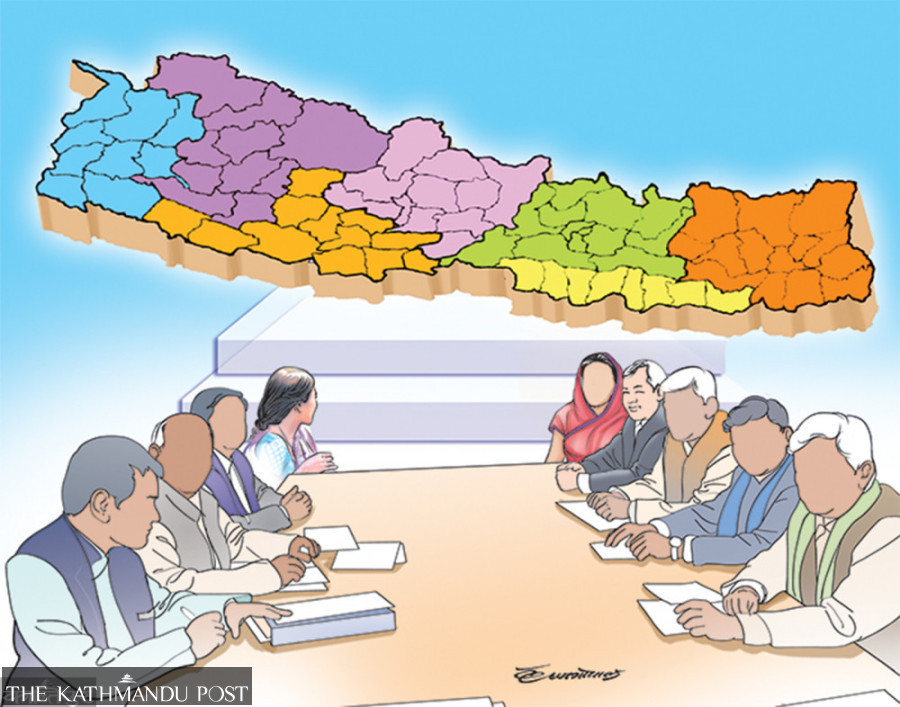Columns
Ceremonial bloat of provincial governors
Nepal cannot afford the luxury of seven ceremonial posts costing taxpayers hundreds of millions annually.
Sanitya Kalika
It has been eight years and two general elections since Nepal took its first step as a federal republic. Over these years, public debates on federalism have largely revolved around provincial boundaries, ethnic lines, distribution of powers and the performance of provincial governments. Far less attention has been paid to a set of offices that exist in every province, consume public resources and yet contribute almost nothing to provinces’ governance—the provincial governors.
Each of Nepal’s seven provinces has a figurehead, appointed by the federal cabinet and described as the ‘constitutional head’ of the province. Their functions are largely ceremonial—like summoning the provincial assembly, swearing the provincial ministers in and assenting to bills. They are performed mechanically—almost always on the advice and consent of the provincial cabinet—without much political judgement. The governors do not govern, just as they don’t legislate or adjudicate. Unlike almost every other political functionary, they are not elected by the people of the province, nor by their representatives. Their appointments and removals depend entirely on the Prime Minister.
Maintaining these seven ceremonial posts is far from cheap. Each post comes with an official residence, a dedicated secretariat, vehicles, security personnel, protocol expenses and staff, costing over Rs 30 million every year for every province. As if those luxuries were not enough, they also have their infamous ‘Bhaisepati palaces’ as residence-cum-contact offices in Kathmandu. For a country where health posts lack lifesaving drugs and infrastructure projects stall due to budget deficit, such extravagance is difficult to justify.
The common defence of the institution of the governor is that it ‘symbolises federalism’—that every province must have a visible figurehead to embody its identity within the federation. But if symbolism is the goal, we must ask, at what cost, and with what actual value to governance (and to the citizens)? A symbol that consumes public resources without delivering substantive benefits is not a strength; it is a liability. It is perhaps a small mercy that the constitution-drafters did not see fit to add a ‘Vice Governor’—another expensive ornament for the federal mantle—to complete the buttress of symbolism.
There is an alternative, one that would not weaken provincial autonomy in any meaningful sense. The Constitution could be amended to make the President of Nepal the figurehead of each province, performing the same ceremonial-cum-constitutional functions now carried out by the governors. For the day-to-day affairs of the provinces—like giving assent to the bills or appointing Ministers—the President would act on the advice and consent of the respective provincial cabinets, just as the Governors do today. For functions that demand control of the federal government, like the dissolution of a provincial government. The President would act on the advice and consent of the federal government, just as they would do today under Article 232(3) of the Constitution.
This change would preserve every real element of provincial self-government. The Chief Minister and their cabinet would retain full executive authority. The provincial assembly would remain the legislative body. The provincial high courts—already established as part of the national judiciary—would remain untouched. Only the ceremonial headship, currently vested in seven separate appointees, would be unified under the office of the President.
Would this ‘centralise’ power in Kathmandu and undo the supposedly coveted and hard-earned federalism? No. Because in both theory and practice, provincial governors are already quite centralised legal persons. They are appointed from Kathmandu and serve entirely at the pleasure of the President, who acts on the advice and consent of the federal cabinet. The President, by contrast, serves a fixed term and can only be removed by impeachment. In situations of political uncertainty, for example, determining who should be invited to form a government when no party has a majority, this independence could make the process less vulnerable to interventions from Baluwatar. Moreover, the President is elected from an electoral college composed of elected representatives from all provinces—unlike the governors who are appointed (and sacked) by the Prime Minister—a process that strengthens the spirit of federalism rather than undermines it.
With only seven provinces, the President’s office would easily manage these ceremonial duties with the support of an expanded provincial affairs secretariat. Unlike India—which has 36 federal units—Nepal’s 7-province federal structure is compact and manageable. Modern communication rarely necessitates physical presence of the President in every province. The President could still visit every province twice a year to address the ceremonial opening of the assemblies, just like the governors do today—a symbolic gesture that would reassure provinces that Kathmandu is not distant or invisible. The text of the address would remain of a kind that is drafted and approved by the relevant provincial cabinet.
Nepal would not be an outlier in making such a change. Ethiopia has no separate appointed ‘governor’ for each kililoch. The President in Addis Ababa is the ceremonial head of the federation and state governments function without a centrally appointed ceremonial counterpart. A German bundesländer headed by its Chief Minister (Ministerpräsident) does not have a ‘governor’, either. Even smaller unions like Comoros function without centrally appointed provincial figureheads for their islands. These examples show that a federal system can survive and thrive without duplicative provincial ceremonial heads.
The main obstacle to making this change is not logistical or constitutional—it will be a political one. Offices, once created, develop their own constituencies. They provide positions for allies, career perks for staff and ceremonial occasions for political theatrics. Even when their practical necessity is questionable, they persist because abolishing them inconveniences the people who benefit from their existence.
Yet, genuine governance reform requires the courage to distinguish between what is necessary and what is ornamental. Nepal’s commitment to federalism is not measured by the number of ceremonial offices it maintains, but by the extent to which provincial governments can actually deliver services, respond to local needs, and make decisions without undue interference. Removing the governors would not diminish these capacities. If anything, the financial savings could enhance them.
Amending the Constitution to abolish the Governors would require a two-thirds majority in the federal parliament, and depending on the interpretation of Article 274, possibly the consent of the provinces. It would also require technical adjustments to Part 13, 14, and 15 of the Constitution in replacing the term ‘Governor’ with ‘President’. This is a perfectly manageable legal exercise. The real challenge will be building political consensus and public awareness of the issue. And given the recent discussions on amalgamating the offices of the Vice President and the National Assembly Chair, such a political move no longer seems far-fetched.
Nepal’s young federalism is still finding its shape. We have an opportunity to refine it—to make it leaner, more efficient and more credible in the eyes of citizens. Seven ceremonial posts costing hundreds of millions each year are not a luxury our country can afford. The presidency is perfectly capable of fulfilling these duties for all provinces. This would not just be symbolic—it would save at least 200 million annually that could go into funding other development agendas of the provinces. Wouldn’t that be the essence of federalism anyway?




 22.85°C Kathmandu
22.85°C Kathmandu

















